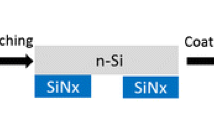Abstract
The effect of hydrogen capping of SiN(Si-rich)/SiN(N-rich) stacks for n-type c-Si solar cells was investigated. Use of a passivation layer consisting of Si-rich SiN with a refractive index (n) of 2.7 and N-rich SiN with a refractive index of 2.1 improved the thermal stability. A single SiN passivation layer with a refractive index of 2.05 resulted in an initial lifetime of 200 μs whereas the layer with a refractive index of 2.7 resulted in a high initial lifetime of 2 ms, but the layer degraded rapidly after firing. A stacked passivation layer with refractive indices of 2.1 and 2.7 had a stable lifetime of 1.5 ms with an implied open-circuit voltage (iV oc) of 720 mV after firing. The thermally stable passivation mechanism with changing amounts of Si–N and Si–H bonding was analyzed by Fourier-transform infrared (FTIR) spectroscopy. Incorporation of the SiN x stack layer (2.7 + 2.1) into the passivated rear of n-type Cz silicon screen-printed solar cells resulted in energy conversion efficiency of 19.69%. Improved internal quantum efficiency in the long-wavelength range above 900 nm, with V oc of 630 mV, is mainly because of superior passivation of the rear surface compared with conventional solar cells.
Similar content being viewed by others
References
A.G. Aberle, Prog. Photovolt. Res. Appl. 8, 473 (2000).
M.J. Kerr and A. Cuevas, Semicond. Sci. Technol. 17, 35 (2002).
S.W. Glunz, A. Grohe, M. Hermle, et al., Proceedings of the 20th European Photovoltaic Solar Energy Conference and Exhibition (Barcelona, Spain, June 2005), pp. 572–577.
S. Dauwe, L. Mittelstadt, A. Metz, and R. Hezel, Prog Photovolt. Res Appl. 10, 271 (2002).
H. Plagwitz, Y. Takahashi, B. Terheiden, and R. Brendel, Proceedings of the 21st European Photovoltaic Solar Energy Conference and Exhibition (2006), pp. 688–691.
J. Schmidt, J.D. Moschner, J. Henze, S. Dauwe, and R. Hezel, Proceedings of the 19th European Photovoltaic Solar Energy Conference and Exhibition (2004), pp. 391–396.
A.G. Aberle, Sol. Energy Mater. Sol. Cells 65, 239–248 (2001).
F. Duerinckx and J. Szulfcik, Sol. Energy Mater. Sol. Cells 72, 231–246 (2002).
K. Koyama, K. Ohdaira, and H. Matsumura, Appl. Phys. Lett. 97, 1–3 (2010).
B. Lenkeit, S. Steckemetz, F. Artuso, and R. Hezel, Sol. Energy Mater. Sol. Cells 65, 317–323 (2001).
B. Hallam, B. Tjahjono, and S. Wenham, Sol. Energy Mater. Sol. Cells 96, 173–179 (2012).
F. Giogris, F. Giuliani, C.F. Pirri, E. Tresso, C. Summonte, R. Rizzoli, R. Gallo, A. Desalvo, and P. Rava, Philos. Mag. B 77, 925–944 (1998).
F.L. Martinez, R. Ruiz-merino, A. Prado, and E. San Andres, et al., Thin Solid Films 459, 203–207 (2004).
J.J. Mei, H. Chen, W.Z. Shena, and H.F.W. Dekkers, J. Appl. Phys. 100, 073516 (2006).
E. Bustarret, M. Bensouda, M.C. Habrard, and J.C. Bruyere, Phys. Rev. B 38, 8171–8184 (1988).
A. Richter, J. Benick, A. Kalio, J. Seiffe, M. Hörteis, M. Hermle, and S.W. Glunz, Energy Procedia 8, 479–486 (2011).
M. Tucci, E. Talgorn, L. Serenelli, E. Salza, M. Izzi, and P. Mangiapane, Thin Solid Films 516, 6767–6770 (2008).
Acknowledgements
This work was supported by the Global Excellent Technology Innovation of the Korea Institute of Energy Technology Evaluation and Planning (KETEP), granted financial resource from the Ministry of Trade, Industry & Energy, Republic of Korea (No. 20135020910050).
Author information
Authors and Affiliations
Corresponding author
Rights and permissions
About this article
Cite this article
Choi, J., Balaji, N., Dao, V.A. et al. Improved Hydrogen Capping Effect in n-Type Crystalline Silicon Solar Cells by SiN(Si-Rich)/SiN(N-Rich) Stacked Passivation. J. Electron. Mater. 43, 3191–3195 (2014). https://doi.org/10.1007/s11664-014-3244-9
Received:
Accepted:
Published:
Issue Date:
DOI: https://doi.org/10.1007/s11664-014-3244-9




